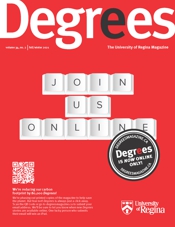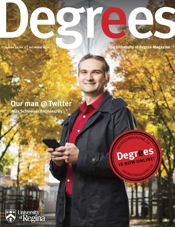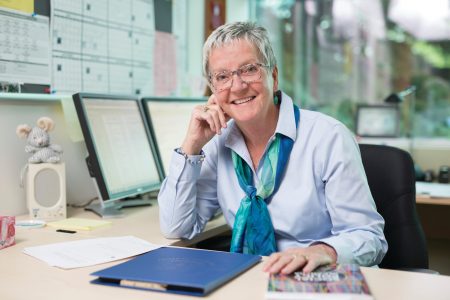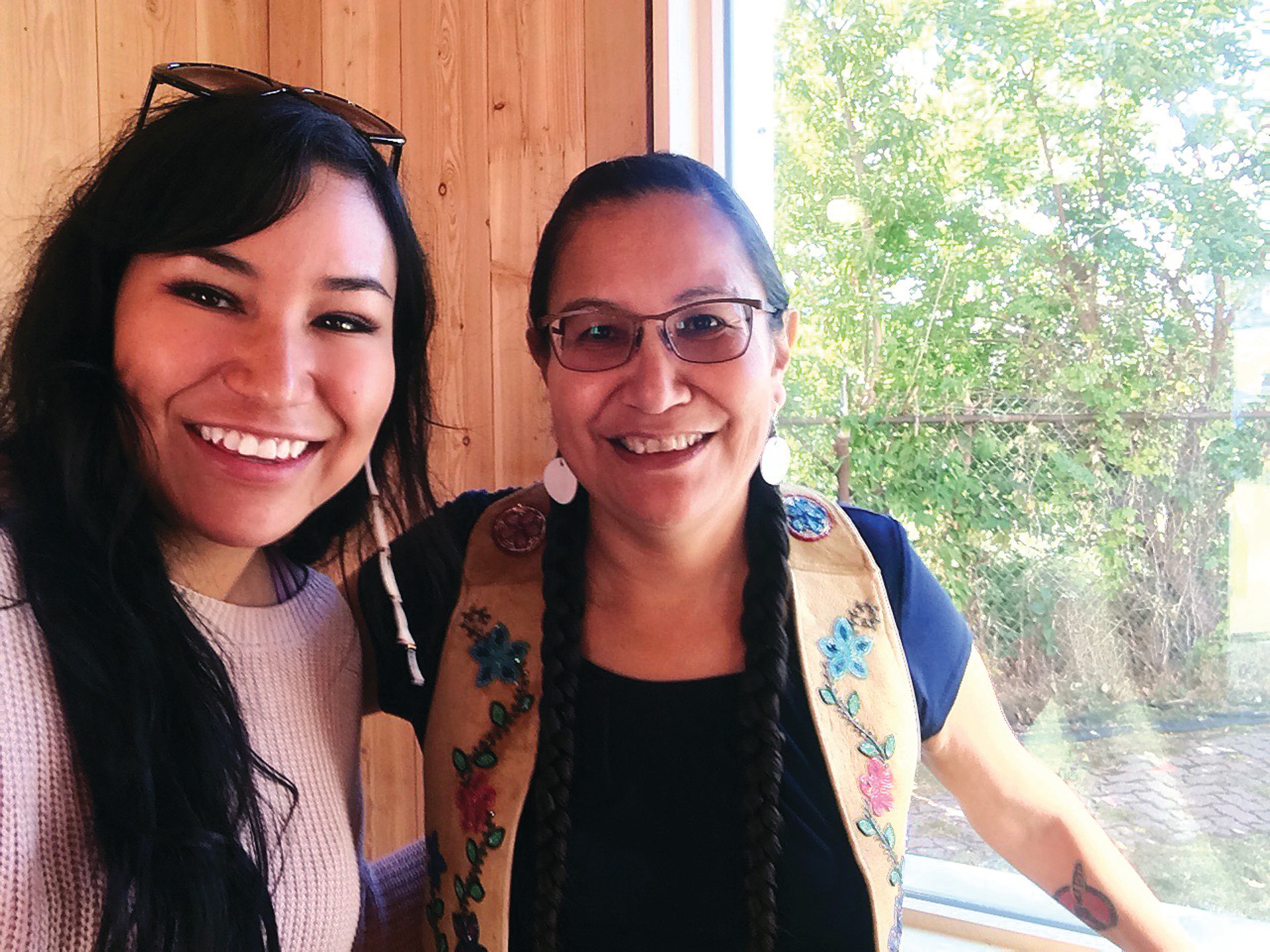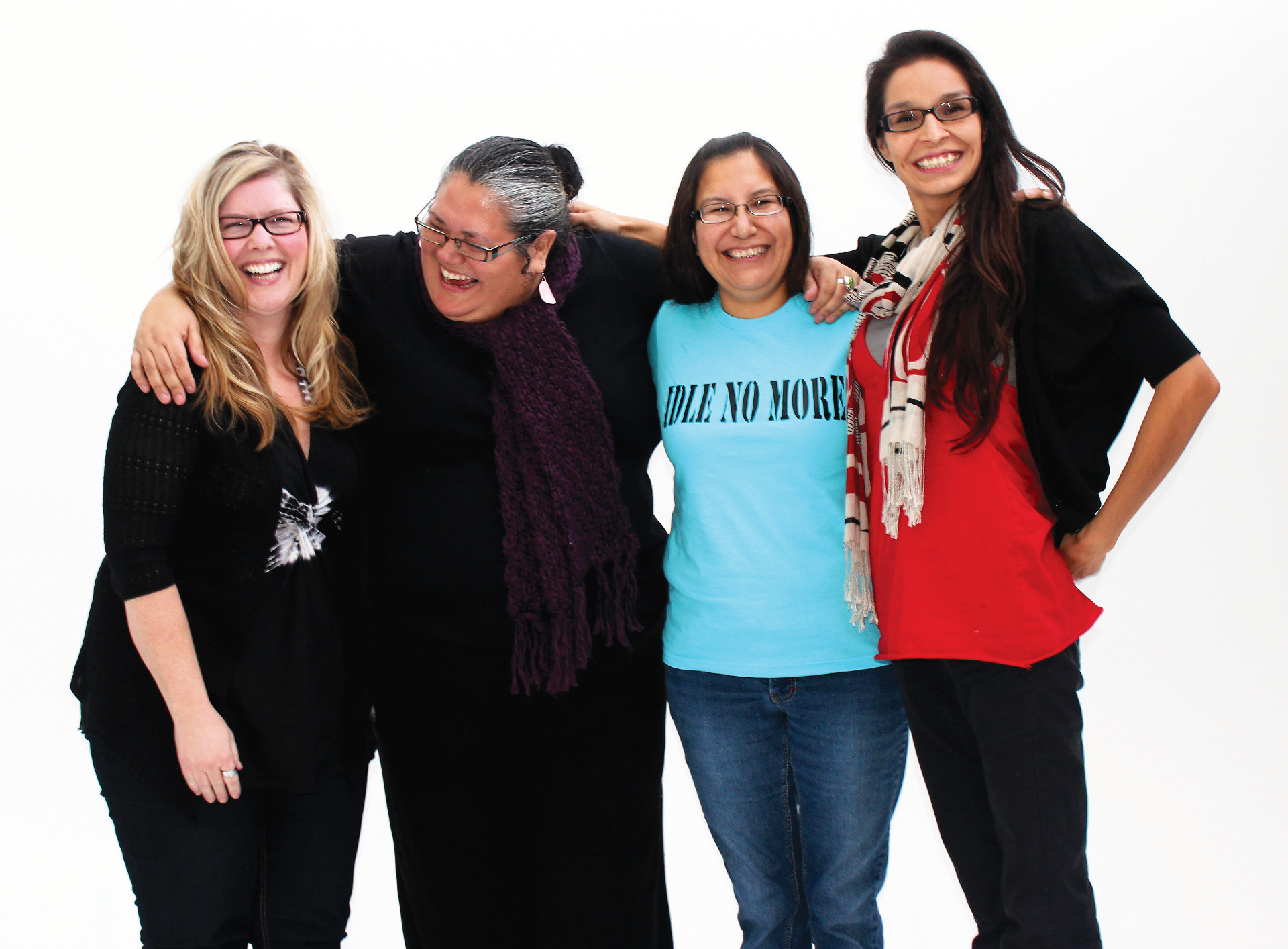Sylvia McAdam Saysewahum never attended residential school. Neither did her grandparents, parents or siblings. They were all hidden away and therefore avoided the legacy of pain that has trickled down through generations of many Indigenous families. Her earliest educational experiences were spent with family, speaking Cree on their traditional hunting lands. Later, sacrifice and persistence in the largely non-Indigenous world earned her human justice and law degrees. In 2012, Saysewahum and three other women founded Idle No More, a worldwide movement protecting the planet from corporate destruction and seeking inherent Indigenous sovereignty. Her unique upbringing and life experience has led to such honours as the Carol Geller Human Rights Award, Foreign Policy’s Top 100 Global Thinkers Award, Social Justice Award and the 2014 Global Citizen Award. It’s also shaped the okihcitâwiskwêw or warrior woman she is today.
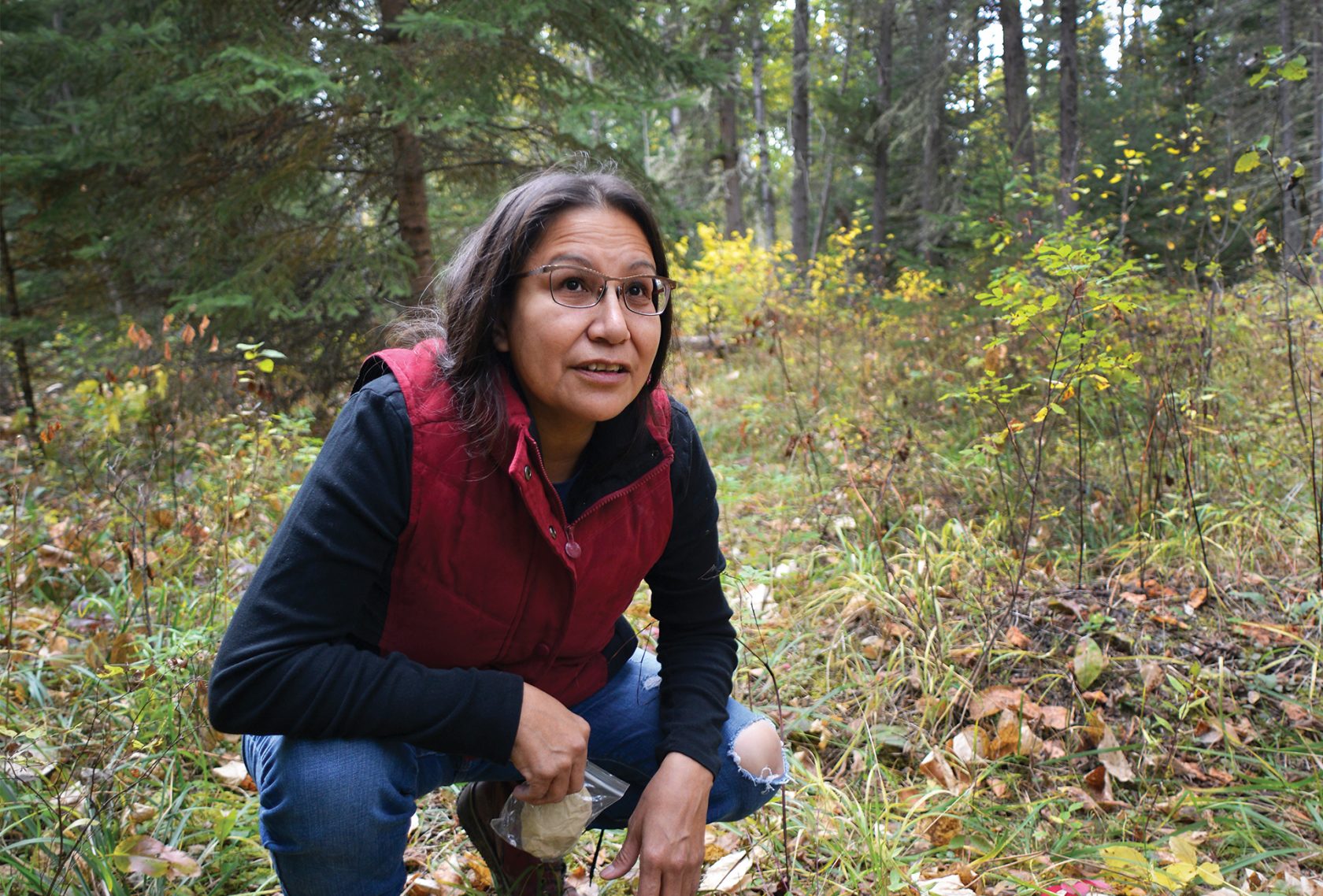
On a cool autumn day, Sylvia McAdam Saysewahum BHJ’98 and two of her children, Richard and Vicky, drive deep into their traditional hunting lands in Treaty 6 territory near what is now Big River First Nation. After a short walk down a winding trail cut into the boreal forest, the family stops at a sacred place that Saysewahum knows well. All around them are the burial mounds of perhaps 1,000 of her people, including her great-grandfather and her great-great-grandfather, who was one of the signatories of Treaty 6. The ancient burial ground is only a short distance from the province’s Zig Zag Bay campground, but it’s doubtful that many of the campers know about its proximity.
Saysewahum kneels at the grave of her great-grandfather and carefully places tobacco in a can located just for the purpose. “When we come here we honour him by giving tobacco to give thanks. Without him, I wouldn’t be here, I wouldn’t speak the language. As much as possible, he and his wife protected us. This is his legacy. We are still carrying on, defending and protecting the land. I carry on his work.”
Saysewahum turns to her children,
“Someday, when I pass on, this is where I want to be buried. Okay?”
Saysewahum has always loved the land. Her earliest and most significant teacher was her father, who heavily influenced her relationship with the land. “My dad significantly impacted the way that my siblings and I interacted with the land. My dad is a skilled hunter. Put him out on the land with a knife and he will survive,” she says. “He had nourished that strong connection for me to the land.”
Saysewahum took her knowledge of the land with her into the classroom. Early in her education, she recalls taking an immediate liking to the sciences. “Science was absolutely something you could apply to the land. When we learned that all things were alive, I totally related to that,” she says. “What I was taught was that everything had a spirit. Everything had a soul. I was taught to respect that. Science reaffirmed that for me in a different way.”
Saysewahum, one of few of her generation who did not attend residential school, did not speak English until kindergarten and is fluent in Cree.
It is the language in which she addresses her children and her grandchildren, as well as her father. It was also the language she used when speaking with her mother until her mother’s passing this year. Cree, or the nêhiyaw language, is so embedded in her upbringing that she still finds herself struggling with English. “There’s certain words I still can’t say. For example, we don’t have the ‘r’ sound in the Cree language,” she says.
Unlike so many generations who attended residential school, Saysewahum was never punished by her kindergarten teacher for speaking her language. “Her kindness has stuck with me,” she says.
Despite the self-admitted struggle with English, Saysewahum has never had a problem speaking about the colonial effects on Indigenous people and their lands to English-speaking audiences.
It was always Saysewahum’s intention to be a voice for her people and her lands. She saw the University of Regina’s social work program on the University of Saskatchewan campus as a way to start that journey, specifically because of the human justice courses it offered.
“I already knew I was going into law. I thought, at the time, that human justice would provide that avenue, and it did.”
While studying, she began to recognize the correlation between violence to the land and violence to Indigenous people. She says the program became a means for her “to gain skills to verbalize the injustices towards Indigenous people.”
“I saw so much injustice,” she says. “So much pain.”
Saysewahum says the program and instructors were crucial to opening doors she never knew existed. When she reflects on her educational experience, she says that the courses struck a chord in her and peeled back layers of colonization. “It was crucial to helping me do what I do now,” she says.
Aside from the class material, Saysewahum was especially influenced by one of her University of Regina instructors, Ailsa Watkinson. Watkinson is still a professor in the Faculty of Social Work at the Saskatoon campus and remembers Saysewahum clearly. “Sylvia sat close to the front,” Watkinson recalls. “Despite being on the quieter side, she hung onto every word. She was an eager learner.”
During the mid-90s, the enrollment rates of Indigenous students were quite low compared to non-Indigenous students. Watkinson recalls Saysewahum being the only Indigenous student in her class at the time. The pair had a strong connection, so much so that Saysewahum invited Watkinson to visit Big River First Nation to witness firsthand the conditions in which her people lived. “It was the first time I had ever been to a First Nations reserve,” Watkinson says. “She took me to see some of the homes people lived in. It was horrifying.”
On-reserve housing has been an ongoing struggle faced by Indigenous communities across Canada. In November 2016, Northern Affairs Minister Carolyn Bennett acknowledged that the government’s $417 million dollar housing boost couldn’t begin to address the crisis faced by Indigenous people today. From lack of energy and heating issues, to undrinkable water, the many housing challenges have yet to be addressed by any government in a meaningful way.
Attending post-secondary school had never been an easy choice for Saysewahum as it meant she would have to leave her family and her land, and relocate with her children to Saskatoon. “Leaving the land for the city was a shock to my system,” she says.
Saysewahum experienced the many difficulties that face Indigenous people who relocate to the city. As a single mother, she was only able to access low-income housing. “Not only was I unable to access the nicer parts of Saskatoon,” she says, “I also witnessed the heavier police presence.” Saysewahum and her friends were all too familiar with frequent stops by Saskatoon police for little to no reason. “It was a bad time for Saskatoon,” she says. “We all heard about the ‘tours’.”
Saysewahum also recounts a time when she was leaving a late night class alone. A truck slowed down behind her and she assumed it was to stop for a red light. She realized she was wrong when the windows were rolled down. Not only were profanities and slurs hurled her way, but pennies were thrown out of the moving vehicle as well. “Although there is violence on my land, those kinds of things weren’t experienced,” she says. “Those kinds of experiences made me feel unsafe in the city.”
Perhaps the biggest obstacle for Saysewahum was that her children experienced the same kind of racism for the first time in the city. They struggled in primary school and Saysewahum recalls making frequent trips to the school’s office while they adjusted. She also saw a severe difference in resources compared to schooling on reserve.
“The adjustment for my kids to go into the Saskatoon public school system meant that they had to work really hard to catch up,” she says. Above all else, though, she worried about their safety.
At the same time her family was trying to adjust to life in the city, Saysewahum was struggling through a violent relationship. While dealing with her abusive relationship and her children’s and her own adjustments to the city, Saysewahum also feared an encounter with social services.
The courses she was taking at the University of Regina offered her a space where she could quietly learn and take in the material, but she never felt the environment was inclusive. “I didn’t think I could talk about being Indigenous,” Saysewahum says. Being the only Indigenous student in many of her courses, she says that her social work class had some very unsettling viewpoints. “I met some of the most racist people I’ve ever encountered,” she says. “It shocked me that they would be going into jobs where they would be largely working with my people.”
Despite the difficulties associated with balancing school work, motherhood and the ongoing effects of colonialism in an urban setting, Saysewahum graduated with a Bachelor of Human Justice in 1998.
Saysewahum always knew that law school was in her future, but the experience was far from idyllic. In addition to having to face racist attitudes at university, her studies also gave her insights into the ways in which the social services system worked against Indigenous people. She saw a system that apprehended children and she loathed it. She decided that studying law would be a strong way to learn the system more clearly. “I wanted to pursue my dream of becoming a lawyer because perhaps that was the place I could make changes,” she says.
“I wanted to correct and help achieve some sort of justice for my people.”
Saysewahum’s loathing is well warranted. Five of the 94 Truth and Reconciliation Commission’s Calls to Action focus on the urgent need for provincial governments to address the high rates of Indigenous children and youth in care – nearly half of the total numbers. In June 2015, Cindy Blackstock, executive director of the First Nations Child and Family Caring Society, stated that today’s rates of Indigenous youth in care exceed the number of children and youth who attended residential schools in the past. As it stands, governments have yet to reverse the growing numbers.
Saysewahum’s dream of helping her people also included protecting traditional lands. “I want freedom, liberation and self-determination for my people, for myself, for my children and for my grandchildren,” she says. Ultimately, her desire to change the world would not come in a court of law. Despite obtaining her degree in 2009, Saysewahum has yet to practice law. The reason, she explains, is the process of being called to the bar. “You have to make an oath to Canada and swear allegiance,” she says. “I refuse to do that. My allegiance is to my people and to my land.”
In the winter of 2012, Saysewahum, Jessica Gordon, Nina Wilson and Sheelah McLean founded the international movement Idle No More. The grassroots initiative was born during highly political times under the Stephen Harper government and sparked national rallies, teach-ins, round dances and protests. By no coincidence, the founding of Idle No More coincided with Saysewahum’s reconnection to her traditional lands.
“I knew I needed to return home. I put my things in storage and I came home. Coming home was spiritual, physical, mental and emotional. I was reminded and fell in love again. I was revived. But I saw the devastation to the land. I began to grieve. It impacts you. I think, at that point, I drew a line right across my people’s land, and I said, ‘I can’t.’ ”
After losing touch, Watkinson said she was not at all surprised to hear of Saysewahum’s work with Idle No More. “She had invited me to one of the earlier meetings of Idle No More. She wanted to host a teach-in, challenging the Harper government, and discuss water and land disputes,” Watkinson says.
Erica Violet Lee was a young, Indigenous student studying philosophy at the University of Saskatchewan when she attended the first Idle No More meeting at Station 20 West in Saskatoon. Lee recalls meeting Saysewahum there for the first time. “The way she spoke was kind, passionate and unafraid,” Lee says. Growing up in the inner city of Saskatoon, Lee was no stranger to the startling conditions in which Indigenous people live, on the Prairies and across the country.
The two have worked on many projects together, including a housing project Idle No More initiated called One House Many Nations. In the winter of 2015, the organization raised $15,000 and purchased a tiny house from an organization based in Manitoba. The home was delivered to Saysewahum’s reserve, Big River First Nation, and gifted to a local man. The project was used to draw national attention to the poor housing and living conditions Indigenous people experience on their own land. Idle No More is hopeful that tiny houses can provide a solution for the sub-standard housing conditions faced by many Indigenous people.
Lee says that working on the project was one of the more moving experiences she has had with Saysewahum. “It was a reminder that housing is a basic right denied to our communities by governments,” she says.
A major catalyst for the widespread popularity of Idle No More was social media. Today, the official Idle No More twitter page boasts more than 39,000 followers; the Facebook group contains nearly 59,000 members; and the website continues to host online traffic from all over the world.
Watkinson’s course on human justice and advocacy fueled Saysewahum’s activism and her knowledge of the law has helped her further advocate for her people and the land. She has also dedicated plenty of her time in the past decade to learning and writing about the tradition legal systems of her people. In 2015, Saysewahum released the book Nationhood Interrupted: Revitalizing nêhiyaw Legal Systems. In it, she shares nêhiyaw (Cree) laws so that future generations, both nêhiyaw and non-Indigenous people, may understand them, live by them and revitalize Indigenous nationhood.
The book has been a useful resource in Lee’s pursuit of education, as well. “It taught me that our laws and love for the land are inextricable,” she says, explaining how the book can keep people grounded.
“Being at university, people become disconnected from our responsibilities to the ground under our feet, and to the communities around us,” Lee says. “Saysewahum’s work, both personally and through the work of Idle No More, remind us to advocate for the land. I hope people are strong and smart enough to support her work,” she says.
One House Many Nations was the recipient of the 2016 Margolese National Design for Living Prize. If the tiny house project wasn’t evidence enough, Saysewahum says the grassroots organization continues to move toward finding solutions. “We know what the problems are,” she says. “We want to provide an awareness that there are solutions and energy alternatives and sustainable ways to live on the land. We want to shift the consciousness of Canada,” she adds.
It’s unlikely the nation’s court rooms or provincial or federal legislatures will propel Canada toward the future Saysewahum so desperately wants to realize. Instead, a bigger driver would be if every young Indigenous person in Canada follows Saysewahum’s example and pursues their education to whatever extent possible.
The advice she offers to those youth is simple and straight forward.
“Learn who you are. Learn your language. Learn about your lands. Learn about the history of the colonizer to understand the in-depth impacts of patriarchy, misogyny, genocide and the doctrine of discovery,”
she says. “Bury your feet deep into the land. Don’t let anyone tell you different: we never ceded or surrendered these lands. Smudge, pray, learn ceremony. Those things saved my life so many times. I couldn’t do this work without that.”
With advice like that and a journey like hers, it’s pretty well certain that Saysewahum will be a source of inspiration for many young warrior women to come.

